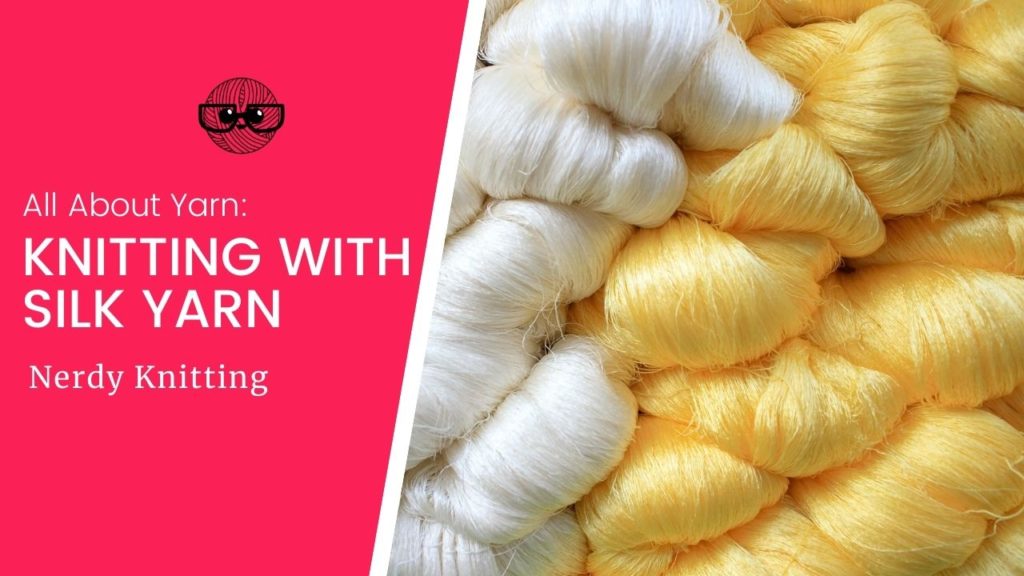Silk yarn is a heavenly fiber to knit with. It’s smooth, sleek, and yes, silky. But there are some things you should know as a knitter before you choose a silk yarn or silk blend for your next knitting project. While silk is wonderful for knitting, it’s a delicate fiber that has some special care needs.
In this article we’ll take a look at the most important things you need to know before you start knitting with silk yarns.
- A Short History of Silk
- How Silk Yarns are Made
- Properties of Silk Yarn
- Knitting with Silk Yarn
- Choosing Knitting Patterns
- Caring for Finished Projects
- Buying Silk Yarns
- More Questions about Knitting with Silk Yarn
Let’s take a closer look at silk yarn and you’ll know exactly when it’s the right fiber for your next knitting project.
Some links below are affiliate links. If you click through and make a purchase I may receive a small commission at no extra cost to you. See the disclosure policy for more information.
A Short History of Silk
Knitting fibers can be divided into four basic categories – animal fibers (like wool, silk, and alpaca), plant fibers (like cotton and linen), biosynthetic fibers (like rayon and bamboo), and synthetic fibers (like acrylic and nylon). Silk is categorized as an animal fiber because, while it isn’t combed or shorn from an animal, the fibers are derived from an animal – the cocoon of the silkworm.
As with other natural fibers like linen, cotton, wool, and even hemp, it has a long history as a textile fiber. It was used in China in ancient times (approximately 3500 BC). Around 300 AD, sericulture (the production of cultivated silkworms) spread to other areas in Asia (mainly Japan and India).
Silk can come from two different sources – either cultivated, where silkworms are fed a steady diet of mulberry leaves (mulberry silk is the most commonly used silk), or it can be cultivated from silkworms found in the wild, which produces a coarser silk fiber.
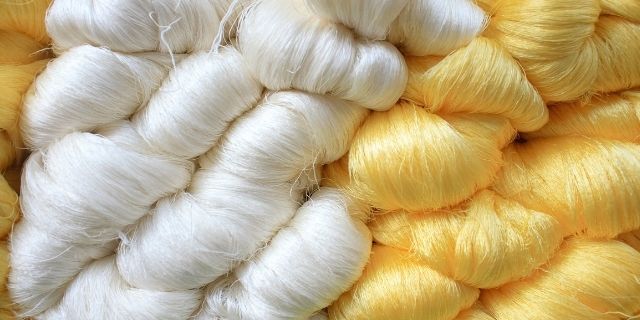
How Silk Yarns are Made
Silk comes from the cocoons of the silkworm. After the moth lays between 400-600 eggs they die. The larvae hatch and feed for about a month (cultivated silkworms are usually fed an exclusive diet of mulberry leaves) as they continue to grow. When they are ready for their next developmental stage, silkworms secret filament threads coated in sericin (a gummy substance) that they then wind around themselves to form their cocoon (this filament can get as long as 1600 yards).
When the silkworm has finished transforming into a moth, it breaks free from its peanut-sized cocoon. While these broken cocoons can be used to create silk, the unbroken cocoons are much more desirable. So the cocoons are divided into two groups. The largest cocoons are set aside to continue the on-going process of cultivating silkworms while the remaining cocoons are harvested for their silk.
To keep the silkworms from breaking their cocoon as they emerge, they are boiled or heated, which kills the pupa, softens the sericin, and makes the filaments easier to unravel. While they are wet, 30-50 filaments are gathered and twisted together into a single silk thread using a hand-operated device that unravels the cocoons. The remaining sericin helps these threads bind together. The silk threads are then rolled into a hank using a swift before they are washed, bleached, and dyed.
It takes approximately 5,500 silkworms to produce one pound of silk.
The damaged cocoons are also processed – the silk filaments are cut into staple lengths like other animal fibers. The shorter fibers are carded and woolen-spun. The longer fibers are combed and worsted-spun.
Properties of Silk Yarn
Silk yarn has some clear advantages, but it also has a few disadvantages that knitters should be aware of. It’s a wonderful fiber for lightweight tops, shawls, and blended with other fibers to add a beautiful sheen and lustre. But, there may be times you want to avoid using silk yarns (I certainly wouldn’t recommend it for dishcloths!).
Advantages of Silk
Silk actually shares many of the same traits as wool – and the two fibers blended together makes a beautiful fabric. But it also has a few traits that makes it stand out as a fiber for knitting and textiles.
Silk:
- drapes well
- doesn’t shrink or stretch very much
- is a good insulator
- is moth and mildew resistant
- absorbs moisture
- isn’t prone to pilling
- has a rich lustre and sheen
- is very smooth
- is exceptionally strong
- takes dyes well
It’s a great choice for so many garments – shawls, sweaters and cardigans, soft accessories, and even socks.
Disadvantages of Silk
While silk has some clear advantages as seen from the long list above, there are a few drawbacks:
- it’s weak when wet
- prone to fading
- heavy
- inelastic
- expensive
The expensive nature is obviously because of the labor-intensive process of collecting the fibers as explained in the previous section. That’s why you’ll often find silk blended with other fibers. This reduces its cost as well as adding some benefits to the blend – especially its lustre and strength.
Discover the Confidence You Need to Fix Your Knitting Mistakes

By the end of this six-part self-paced course, you’ll be able to read your knitting, recognize a variety of knitting mistakes, and understand how to fix them.
Knitting with Silk Yarn
Silk yarn and yarn blends are wonderful to knit with as the silk adds a smoothness and softness to the knitting experience. It’s also very strong but does weaken when wet and is prone to fading. It works best when it’s blended with other fibers (especially wool). And a little goes a long way – the addition of 5 or 10% silk to a blend adds all of the benefits of this beautiful fiber. But because it is prone to fading and can get heavy, it’s best to stick to blends where silk is limited to about 15% of the fiber contents of a particular yarn (particularly for sweaters and cardigans).
Be cautious of the needles you use with your silk blend yarns. For an especially slick fiber (if silk is blended with plant fibers, for example), wood, bamboo, or plastic needle will provide more ‘grip’ for your stitches. Slippery yarns have a tendency to slip right off metal needles.
It’s easy to tense up and knit more tightly with 100% silk because it can be slippery – which can cause your hands to feel cramped or sore. Silk is also less elastic than wool which can also exacerbate this issue. So try to relax and not tense your hands while knitting with yarns that contain a lot of silk.
Choosing Knitting Patterns
The sky is the limit when it comes to knitting with silk yarn and silk blends. It’s a wonderful choice for all types of garments – shawls, sweaters, cardigans, cowls, hats, and other accessories. It adds wonderful sheen, strength, and drape to garments.
It’s not a great choice for projects that will need to be washed and used a lot – dishcloths, children’s clothing, hand towels, etc. Because these types of projects are either washed frequently or intended to get wet, silk isn’t a good choice because it’s naturally weaker when it’s wet.
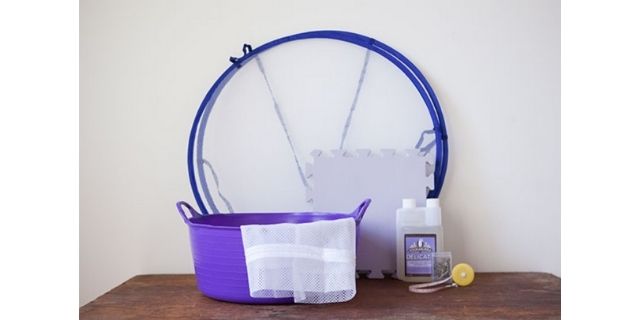
Caring for Finished Projects
One of the disadvantages of knitting with silk is the special care it needs. While you can get it wet to clean it, you need to treat it very gently because of its inherent weakness when wet. Most silk yarns and yarn blends will be hand-wash only (but always check the yarn label for appropriate care instructions).
When you are washing by hand, be sure to gather the whole garment in your hands to keep from damaging the fibers. Don’t let the wet garment stretch or sag.
Spray blocking is also a great way to refresh silk garments. Place on a towel or blocking board, pinning to shape if necessary, and spray until the fabric is wet to the touch. Let dry completely before moving.
Silk yarns can also be VERY GENTLY steamed, so a quick refresh with a hand-held garment steamer or a clothes iron set to medium (never press the iron on the garment – just use the steam feature, holding the iron about an inch or so away from the fabric) is also a good choice for hand-knit items.
Blocking Projects Knit with Silk Yarn
Because of the weakness that is evident when silk gets wet, spray blocking is the best choice for silk yarns but hand washing is possible. It’s best to knit a small swatch and test first – just to be on the safe side!
Spray-blocking: Place the garment on a towel or blocking board. Pin to shape, if needed. Lightly spray with lukewarm water until the garment is wet. Dab off any excess water (especially around pins or wires). Let the garment dry completely.
Hand washing silk: Fill a small basin with cool to lukewarm water and a little mild detergent. Submerge the garment in the liquid, using your fingers to dislodge any stains. Let the garment soak for a few minutes. To rinse the garment, hold it to one side of the basin as you drain the water and add fresh water. When you’re ready to dry the garment, gather the whole garment in your hands, lifting it gently from the water and carefully squeezing out the water. Place the garment on a towel, roll it up, and press out the excess water.
Wet-blocking: After washing, place the garment on a dry towel or mesh sweater dryer and place it in its final shape, being careful to lightly stretch any lace or other openwork designs to showcase them.
Buying Silk Yarns
Silk is a beautiful, versatile fiber with so many uses. You can use 100% silk for an extra special project or use blends that include some silk. Below you’ll find a collection of yarns that include silk – perfect for your next knitting project.
100% Silk Yarns
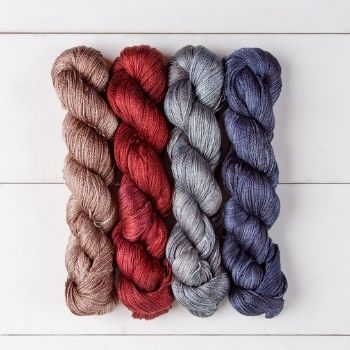
I usually stick to silk added to yarns and blended with other fibers but there are some 100% silk yarns available if you really want to splurge on a project (a silk shawl would be absolutely lovely) or try a more rustic silk. Take a look at some of these yarns for those special projects:
- Knit Picks Luminance Hand Painted
- Lion Brand LB Collection Hand Dyed Silk Yarn
- Malabrigo Mora
- Ella Rae Rustic Silk
- Berroco Mantra
Wool & Silk Blends
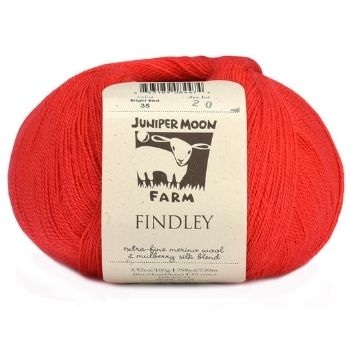
Wool and silk are a beautiful combination. Wool provides elasticity, warmth, and springiness to a garment while silk adds a beautiful shine, drape, and strength. The following yarns are great choices for special sweaters, cardigans, or accessories.
- Knit Picks Gloss Fingering (also available in Lace & DK)
- Knit Picks Paragon Sport (wool, alpaca, silk)
- Malabrigo Silky Merino
- Juniper Moon Farm Findley
- Sweet Georgia Merino Silk Lace
Mohair & Silk Blends
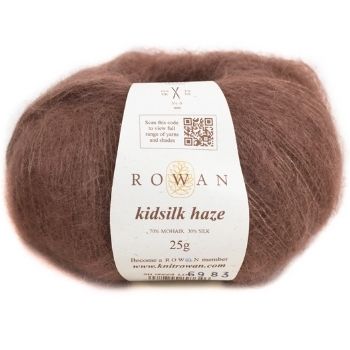
Silk is often blended with brushed mohair in a lace weight yarn. This is a popular yarn for so many projects – used alone for luxurious accessories or held double stranded with another yarn. If a knitting pattern calls for a lace weight blend like this, these are some great choices:
- Knit Picks Aloft Super Kid Mohair
- Rowan Kidsilk Haze
- Berroco Aerial
- Debbie Bliss Angel
- Ella Rae Silky Kid
Silk & Cotton/Linen Blends
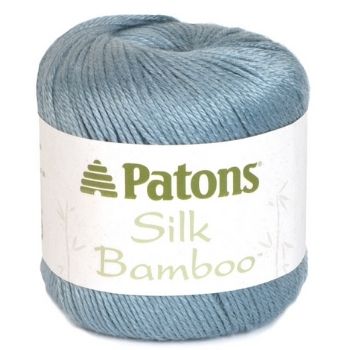
Silk is often blended with cotton, linen, and other plant fibers – it makes a great addition because it adds strength and also adds its softness and shine. And, while these types of yarns are perfect for summer tops, they are also great for shawls and other projects where you want plenty of drape.
More Questions about Knitting with Silk Yarn
While I’ve addressed many topics around silk yarn and knitting with that beautiful fiber, you may be looking for a quick response to a specific question so I’ve collected those common questions to answer right here.
What is silk yarn good for?
Silk is a great choice for beautiful shawls but also provides, strength, shine, and a beautiful lustre when it’s blended with other fibers. It’s a good choice when it’s blended with wool for sweaters, cardigans, and accessories like hats and cowls. When blended with cotton or linen it’s perfect for summer tops and tanks.
What type of yarn is silk?
Most commercially available silk yarns are mulberry silk. More rustic yarns are available that use other sources.
How do you wash silk yarn?
Project knit with silk yarn should be hand washed as silk is very fragile when it’s wet. Handle it carefully as you remove it from the water, squeezing out the excess water before rolling it in a towel to remove even more water. Then lay it flat to dry on a towel or mesh dryer.
More About Yarns & Fibers
- The Knitter’s Book of Yarn by Clara Parkes (available at Amazon)
- Yarn Substitution Made Easy by Carol J. Sulcoski (available at Amazon)
- The Fleece & Fiber Sourcebook by Carol Ekarius & Deborah Robson (available at Amazon)
- Silky Little Knits by Alison Crowther-Smith (available on Amazon)
Related Knitting Articles
- Yarn 101: Knitting with Plant Fibers
- All about Knitting with Alpaca Yarn (& Llama & Vicuña Yarn)
- A Beginner’s Guide to Yarn Substitution
